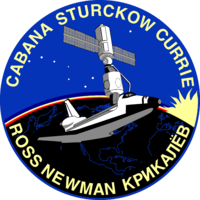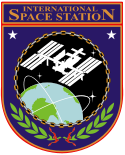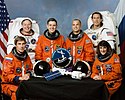STS-88
 | |
| Dane misji | |
| Indeks COSPAR | 1998-069A |
|---|---|
| Zaangażowani | |
| Oznaczenie kodowe | STS-88 |
| Pojazd | |
| Wahadłowiec | |
| Załoga | |
 W białych kombinezonach, od lewej: Jerry Ross i James Newman. Pozostali to, od lewej: Siergiej Krikalow, Robert Cabana, Frederick Sturckow, Nancy Currie. | |
| Dowódca | |
| Start | |
| Miejsce startu | Stany Zjednoczone, KSC, LC39-A |
| Początek misji | |
| Orbita okołoziemska | |
| Apogeum | 401 km |
| Perygeum | 388 km |
| Okres orbitalny | 92,4 min |
| Inklinacja orbity | 51,6° |
| Lądowanie | |
| Miejsce lądowania | KSC, Pas startowy 15 |
| Lądowanie | |
| Czas trwania misji | 11 dni, 19 godzin, 17 minut i 55 sekund |
| Przebyta odległość | 7,6 mln km[1] |
| Liczba okrążeń Ziemi | 185[1] |
| Program lotów wahadłowców | |
STS-88 (ang. Space Transportation System) – trzynasta misja wahadłowca Endeavour, w czasie której na orbitę dostarczony został drugi segment Międzynarodowej Stacji Kosmicznej – Unity.
Był to dziewięćdziesiąty trzeci lot w ramach programu lotów wahadłowców[3]. Z lotem związana jest teoria spiskowa o Czarnym Rycerzu.
Załoga
- Robert Cabana (4)* – dowódca
- Frederick „Rick” Sturckow (1) – pilot
- Nancy J. Currie (3) – specjalista misji 2
- Jerry Ross (6) – specjalista misji 1
- James Newman (3) – specjalista misji 3
- Siergiej Krikalow (4) – specjalista misji (Rosja)
- *(liczba w nawiasie oznacza liczbę lotów odbytych przez każdego z astronautów)
Parametry misji
- Masa:
- Perygeum: 388 km[5]
- Apogeum: 401 km[5]
- Inklinacja: 51,6°[5]
- Okres orbitalny: 92,4 min[5]
Dokowanie do ISS
- Połączenie z ISS: 7 grudnia 1998, 02:07:00 UTC
- Odłączenie od ISS: 13 grudnia 1998, 20:24:30 UTC
- Łączny czas dokowania: 6 dni 18 godzin 17 minut 30 sekund
Spacery kosmiczne
- J. Ross i J. Newman – EVA 1
- Początek EVA 1: 7 grudnia 1998 – 22:10 UTC
- Koniec EVA 1: 8 grudnia – 05:31 UTC
- Łączny czas trwania: 7 godzin 21 minut
- J. Ross i J. Newman – EVA 2
- Początek EVA 2: 9 grudnia 1998 – 20:33 UTC
- Koniec EVA 2: 10 grudnia – 03:35 UTC
- Łączny czas trwania: 7 godzin 2 minut
- J. Ross i J. Newman – EVA 3
- Początek EVA 3: 12 grudnia 1998 – 20:33 UTC
- Koniec EVA 3: 13 grudnia – 03:32 UTC
- Łączny czas trwania: 6 godzin 59 minut
Cel misji
Pierwsza misja montażowa stacji kosmicznej ISS, umieszczenie na orbicie modułu Node-1 (zwanego też Unity), który został dołączony do rosyjskiego modułu Zaria (wyniesionego w listopadzie 1998 roku przy pomocy rakiety Proton)[3].
Zobacz też
Przypisy
- ↑ a b c d podsumowanie misji STS-88 na stronie KSC (ang.)
- ↑ a b c d Mark Wade: STS-88 (ang.). W: Encyclopedia Astronautica [on-line]. [dostęp 2017-07-25].
- ↑ a b c Tomáš Přibyl: Dzień, w którym nie wróciła COLUMBIA. Debit, Czerwiec 2003. ISBN 83-7167-224-1.
- ↑ Robert Godwin: Space Shuttle. Warszawa: Prószyński Media Sp. z o.o., 2011, s. 80, seria: Historia podboju Kosmosu. ISBN 978-83-7648-973-5.
- ↑ a b c d STS 88 (ang.). W: NSSDC Master Catalog [on-line]. NASA. [dostęp 2014-06-20]. [zarchiwizowane z tego adresu (2015-04-05)].
Linki zewnętrzne
- podsumowanie misji STS-88 na stronie KSC (ang.)
- Mark Wade: STS-88 (ang.). W: Encyclopedia Astronautica [on-line]. [dostęp 2017-07-25].
- Spaceflight mission report: STS-88 (ang.). Spacefacts. [dostęp 2017-07-25].
Media użyte na tej stronie
The flag of Navassa Island is simply the United States flag. It does not have a "local" flag or "unofficial" flag; it is an uninhabited island. The version with a profile view was based on Flags of the World and as a fictional design has no status warranting a place on any Wiki. It was made up by a random person with no connection to the island, it has never flown on the island, and it has never received any sort of recognition or validation by any authority. The person quoted on that page has no authority to bestow a flag, "unofficial" or otherwise, on the island.
Designed by the crew members, this patch commemorates the first assembly flight to carry United States-built hardware for constructing the International Space Station (ISS). This flight's primary task is to assemble the cornerstone of the Space Station: the Node with the Functional Cargo Block (fgb). The rising sun symbolizes the dawning of a new era of international cooperation in space and the beginning of a new program: the International Space Station. The Earth scene outlines the countries of the Station Partners: the United States, Russia, those of the European Space Agency (ESA), Japan, and Canada. Along with the Pressurized Mating Adapters (PMA) and the Functional Cargo Block, the Node is shown in the final mated configuration while berthed to the Space Shuttle during the STS-88/2A mission. The Big Dipper Constellation points the way to the North Star, a guiding light for pioneers and explorers for generations. In the words of the crew, "These stars symbolize the efforts of everyone, including all the countries involved in the design and construction of the International Space Station, guiding us into the future."
STS088(S)002 (November 1998):
Five NASA astronauts and a Russian cosmonaut assigned to the STS-88 mission, scheduled for an early December launch, take time out from their busy training agenda for a crew portrait. Seated in front are Sergei K. Krikalev, a mission specialist representing the Russian Space Agency (RSA), and astronaut Nancy J. Currie, mission specialist. In the rear, from the left, are astronauts Jerry L. Ross, mission specialist; Robert D. Cabana, mission commander; Frederick W. Sturckow, pilot; and James H. Newman, mission specialist.



